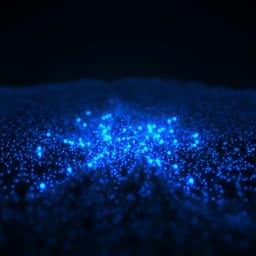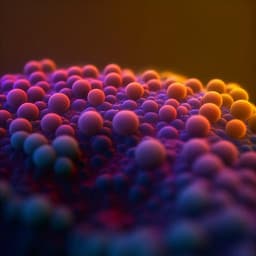
Engineering and Technology
Solution-processed quantum-dot light-emitting diodes combining ultrahigh operational stability, shelf stability, and luminance
Z. Ye, M. Chen, et al.
Discover how a novel bilayer electron-transporting layer design using SnO₂ nanoparticles is revolutionizing quantum-dot light-emitting diodes (QLEDs) by addressing shelf-stability issues and enhancing performance. This cutting-edge research led by Zi Ye, Mengyu Chen, Xingtong Chen, Wenchen Ma, Xiaojuan Sun, Longjia Wu, Xiongfeng Lin, Yu Chen, and Song Chen achieved remarkable luminance levels and operational lifetimes, all while completely inhibiting positive aging.
~3 min • Beginner • English
Introduction
Quantum-dot light-emitting diodes (QLEDs) promise high display performance and low manufacturing cost but face challenges in device stability. Beyond the underperforming operational stability of blue QLEDs, shelf stability driven by ZnO-induced positive aging is a major barrier; high electroluminescence performance often requires unpredictable shelf storage. Prior studies have linked positive aging to changes in ZnO conductivity and reduced QD photoluminescence quenching, attributed to factors such as oxygen vacancies, reactions with encapsulation resin, and surface stabilization (HO–ZnO). However, isolating ZnO from ambient reactants or simple capping has not fully resolved shelf stability without sacrificing performance. Previous strategies include using ultra-small, insulating ZnO to reduce quenching (limiting current density) or SnO₂-based ETLs (with better shelf stability but lower mobility limiting luminance). The goal here is to achieve both shelf stability (no positive aging) and high luminance/operational lifetime by combining SnO₂ and ZnO in a bilayer ETL, with ZnO surface capping to reduce surface activity.
Literature Review
Prior work identified that solution-processed ZnO nanoparticles become more conductive and quench QD PL less after positive aging. Explanations include oxygen vacancies (Chen et al.), chemical reactions with encapsulation resin (Acharya et al.), and general surface stabilization via HO–ZnO (Zhang et al.). Attempts to passivate ZnO surfaces using various ligands demonstrated partial passivation but lacked consistent device-level success, likely due to abundant active surface sites and insufficient coverage. An alternative approach used ultra-small ZnO NPs (<~2.1 nm) to reduce exciton quenching and achieved combined operational and shelf stability in ZnO bilayers, but at the expense of current density and maximum luminance. SnO₂ NP-based ETLs, with less active surface chemistry than ZnO, enabled shelf-stable QLEDs and competitive lifetimes without ZnO; however, limited mobility curtailed maximum luminance. These findings motivate a bilayer ETL combining SnO₂ and ZnO to retain ZnO’s conductivity while suppressing interfacial quenching.
Methodology
- Materials and device design: Developed an ETL bilayer comprising a SnO₂ nanoparticle buffer adjacent to QDs and an overlayer of ZnO nanoparticles (capped with 3-mercapto-1-hexanol, MHL) to maintain high electron conductivity and reduce surface reactivity. Conventional bottom-emitting QLED structure on ITO/PEDOT:PSS/TFB was used with CdSe/Cd1−xZnxSe/ZnSe QD emissive layer.
- ZnO surface capping: Post-synthesis ligand exchange using MHL to cap ZnO NPs. Verification by FTIR (suppression of carboxylate peaks at 1566 and 1424 cm^-1 and presence of –CH2– stretching at 2935 and 2856 cm^-1) and XPS (emergence of S 2p at ~163 eV; Zn 2p shift from 1022.0 to 1021.8 eV indicating Zn–S bonding). TEM showed no size change.
- SnO₂ buffer preparation: TMAH-treated SnO₂ NPs dispersed in ethanol (compatible with solution processing). Layer thickness optimized (~12 nm) to tune charge balance.
- Spectroscopy and interfacial dynamics: Temporal PL (under O2 exposure and UV excitation) used to assess remaining active adsorption sites on ZnO vs s-ZnO. Time-resolved PL (TRPL) of QDs on quartz, s-ZnO/quartz, and SnO₂/s-ZnO/quartz to evaluate exciton quenching (bi-exponential fits). Ultraviolet photoelectron spectroscopy (UPS) with sequential deposition probed energy-level alignment across QD/SnO₂/ZnO stacks; optical bandgaps measured to construct band diagram.
- Device characterization: L–J–V curves, EL spectra, and electroluminescence efficiencies (EQE, current efficiency) compared for devices using s-ZnO vs SnO₂/s-ZnO ETLs. Operational lifetimes measured under constant current density; lifetimes extrapolated using an acceleration factor. Shelf stability assessed by tracking Vth, EQEmax, and EQE at 1000 cd m^-2 vs storage time; pixel imaging for dark spots.
- Electro-absorption (EA): Bias-dependent EA of QD layer used to extract flat-band voltage of the emissive layer (V_FB_EML) to assess energy-level stability and exciton quenching effects.
- Photovoltaic mode EQE (EQE_py): Measured under photovoltaic operation to isolate photoinduced electron transfer from QDs to ETLs across super-bandgap and sub-bandgap excitation regimes.
- Synthesis details (Methods): ZnO NPs synthesized from Zn acetate in DMSO reacted with TMAH in ethanol; MHL capping performed with MHL and TMAH in ethanol. TMAH-SnO₂ NPs prepared per prior report and dispersed in ethanol. Red CdSe/Cd1−xZnxSe/ZnSe QDs synthesized via hot injection with staged Se injections and shell growth.
Key Findings
- A SnO₂ (buffer)/capped-ZnO (s-ZnO) bilayer ETL simultaneously ensures shelf stability (suppressed positive aging), high luminance, and long operational lifetime.
- Luminance: Devices with SnO₂/s-ZnO ETL achieve maximum luminance exceeding 100,000 cd m^-2; in fully characterized L–J–V data, maximum luminance approaches ~200,000 cd m^-2.
- Operational lifetime: Without shelf storage, SnO₂/s-ZnO devices show average T95 ≈ 6200 h (champion 7200 h) at 1000 cd m^-2; this translates to T95 ≈ 390,000 h at 100 cd m^-2. s-ZnO- or ZnO-only devices require shelf storage to reach similar T95 (~5600–5800 h); freshly made ZnO-only device shows T95 ≈ 2500 h at 1000 cd m^-2.
- Shelf stability: For s-ZnO-only devices, EQEmax increases from 10.3% (fresh) to 14.9% (day 7), and Vth decreases from 1.8 V to 1.7 V—evidence of positive aging. In contrast, SnO₂/s-ZnO devices show storage-time-independent L–J–V, stable EQE, Vth, and prevention of dark spot formation.
- Interfacial quenching and dynamics: TRPL fast component τ1 for QDs: quartz (8.29 ns), s-ZnO/quartz fresh (6.98 ns) increasing to 8.14 ns after 7 days (aging), and SnO₂/s-ZnO/quartz is 8.08 ns without aging and remains stable over 7 days, indicating suppressed exciton quenching with SnO₂ buffer.
- Energy-level alignment: UPS-derived band alignment shows vacuum-level shifts at QD–SnO₂ (downward) and SnO₂–ZnO (upward) interfaces, enabling efficient electron injection; SnO₂ thickness serves to tune charge balance.
- EA-derived V_FB_EML: s-ZnO device V_FB_EML increases from ~0.8 V to ~1.3 V after 7 days (reflecting evolving ZnO surface/Fermi level). SnO₂/s-ZnO device shows stable V_FB_EML ≈ 1.7 V, consistent with suppressed interfacial quenching and stabilized electron quasi-Fermi level.
- Photovoltaic EQE (EQE_py): Adding SnO₂ reduces super-bandgap EQE_py by nearly two orders of magnitude and sub-bandgap response by ~10×, consistent with suppressed photoinduced electron transfer from QDs to ETL and fewer active surface states on SnO₂.
- Charge balance and leakage: SnO₂ buffer does not significantly impede electron injection (similar Vth to s-ZnO) but suppresses leakage current (mainly hole leakage through ETL). Optimized SnO₂ thickness (~12 nm) yields peak EQE and current efficiency at low bias (~2.3 V).
- ZnO capping: MHL capping diminishes ZnO surface activity (FTIR/XPS) and reduces, but does not eliminate, visible PL associated with surface states; pairing with SnO₂ buffer is essential to fully suppress positive aging at device level.
Discussion
The study addresses the core challenge of ZnO-induced positive aging and shelf instability in solution-processed QLEDs by engineering the QD/ETL interface. While MHL capping partially stabilizes ZnO surfaces, remaining active sites still permit exciton quenching, limiting shelf stability. Introducing a SnO₂ nanoparticle buffer between QDs and ZnO effectively blocks charge transfer channels responsible for exciton quenching. UPS-derived energy-level alignment indicates that the SnO₂ layer produces favorable vacuum-level shifts and allows efficient electron injection while enabling thickness-based tuning of charge balance. TRPL shows that SnO₂ restores QD exciton lifetimes to near-quartz values without requiring shelf storage, directly evidencing reduced interfacial quenching. EA confirms that the bilayer ETL stabilizes the flat-band condition (V_FB_EML), and photovoltaic EQE measurements show orders-of-magnitude suppression of photoinduced electron transfer in the super-bandgap regime, attributable to smaller CBM offsets and fewer active surface states on SnO₂. Collectively, these results demonstrate that the SnO₂/s-ZnO bilayer eliminates positive aging while retaining ZnO’s high conductivity, delivering high luminance and long operational lifetimes with stable device characteristics over shelf storage.
Conclusion
A SnO₂ buffer layer combined with MHL-capped ZnO in a bilayer ETL enables solution-processed QLEDs that concurrently achieve shelf stability (no positive aging), ultrahigh luminance (>100,000 cd m^-2, approaching ~200,000 cd m^-2), and long operational lifetimes (T95 ≈ 6200 h at 1000 cd m^-2; extrapolated ≈390,000 h at 100 cd m^-2). Spectroscopic (TRPL), electrical (EA), and photovoltaic (EQE_py) analyses reveal that the SnO₂ layer suppresses interfacial exciton quenching by reducing photoinduced electron transfer and stabilizing energy-level alignment, while ZnO preserves strong electron transport. This approach delivers competitive overall performance for QLED displays without relying on unpredictable shelf aging.
Limitations
- Incomplete ZnO surface passivation by MHL: visible emission associated with surface states is not entirely eliminated, indicating low ligand coverage and residual active sites on ZnO.
- Depth profiling constraint: UPS measurements performed via sequential deposition cannot provide a complete depth profile due to solution processing, so interfacial energy alignment is inferred rather than directly profiled through the entire stack.
- Mobility trade-offs: Although the bilayer restores high luminance, SnO₂ nanoparticle mobility is intrinsically lower than ZnO; careful thickness optimization (~12 nm) is required to maintain charge balance and suppress leakage.
- Sensitivity to ETL thickness: Device performance (EQE, current efficiency, leakage) depends on precise control of SnO₂ buffer thickness; non-optimized layers can degrade charge balance and efficiency.
Related Publications
Explore these studies to deepen your understanding of the subject.







